

Vol. 40 (Number 30) Year 2019. Page 16
PLAZAS-ROSAS, Ramiro A. 1 & FRANCO-MEJÍA, Édinson 2
Received: 30/05/2019 • Approved: 18/08/2019 • Published 09/09/2019
3. Results: Application of the proposed methodology
ABSTRACT: This article presents a methodology to aid novice investigators initiate a review of any topic, either to define their research problem or to embark upon a detailed literature review. The methodology provides inexperienced researchers with a panorama of projects already carried out in their specific field, avoiding the time-consuming job of starting the required background research from scratch. Additionally, it could be applied to any field of knowledge and in different scenarios, offering a strong starting point for any investigation. |
RESUMEN: Este artículo presenta una metodología para ayudar a los nuevos investigadores a iniciar una revisión de cualquier tema, ya sea para definir su problema de investigación o para iniciar una revisión detallada de la literatura. La metodología proporciona a los investigadores inexpertos un panorama de proyectos ya realizados en su campo específico, evitando iniciar la investigación desde cero. Además, podría aplicarse a cualquier campo de conocimiento y en diferentes escenarios, ofreciendo un punto de partida sólido para cualquier investigación. |
Doctorate programs have been offered by universities in Colombia for no more than 30 years (Jaramillo, 2009) which can be considered recent in the global context. However, most teacher-researchers in colombian universities have international academic experience, which academically enriches their national programs. These experiences have been passed on to students through classes in research and through the development of research projects. In addition, it is necessary to translate the experiences acquired in order to offer tools to the next generation of investigators contributing to the body of academic research. It is also crucial to develop strategies such as the one proposed by (Sugiyama & Meyer, 2008), which consists of constructing a framework for the systematic analysis of knowledge processes through knowledge process modeling, synthesis, and reflective verification.
Master's and Doctoral students often experience confusion when beginning their research activities. A primary concern is the formal definition of their research problem (also known as ‘open problems’ or OPs) associated with research topics (Baker, Brizee, & Velázquez, 2013; Institute for Writing Rhetoric. Dartmouth College, 2016; Labaree, 2017; University of California Santa Cruz, 2018). This lack of clarity or focus is common when students must establish a more defined research topic and/or research problem.
According to data from the Labor Observatory of Colombia’s Ministry of National Education (Ministerio de Educación Nacional de Colombia, 2018), of all the degrees awarded nationally by Higher Education Institutions between 2001-2016, 3,89% were Masters or Doctoral degrees. The Master’s and Doctorate degrees from Universidad del Valle only make up 0.17% of all degrees awarded nationally. In the Postgraduate Program of Electrical Engineering and Electronics (PPIEE in Spanish) and in the Industrial Control Research Group -GICI-, the research projects developed by master’s and doctoral students, for example (Avella-Rodríguez, 2015; Bastidas-Rodriguez, Franco-Mejia, Petrone, Ramos-Paja, & Spagnuolo, 2014; Gomez-Luna, Aponte Mayor, Gonzalez-Garcia, & Pleite Guerra, 2013; Plazas-Rosas, 2014), among others, follow the guidelines and recommendations made by the research tutors. Therefore, the main contribution of this paper is to present a guide for the novice researcher, clarifying concepts, and providing a methodology and tools for developing investigations.
In order to demonstrate the application of the methodology proposed, three applications or case-studies are presented with the following research titles: ‘Experimentation Tools in Local Control Systems: A survey’, ‘Noninvasive measurement of blood pressure’ and ‘The trend of a topic’.
Within the broad scope of the sciences, there are many subjects, topics and research problems and this is reflected in the very high number of publications, many highly specialized. For example, some research topics are active teaching-learning methodologies, tools with Information Technologies (IT) for education, control of generation and distribution of electricity, control of generation and distribution of electric energy with Smart-Grids, among others (Aminifar et al., 2015; Jiang & Zheng, 2016; Núñez S., Lascano F., & Esparragoza, 2013).
When only the subject is defined, the task of finding topics or OPs is an ambitious task due to the multiplicity of topics in which the development of OPs is relevant or connected.
A useful analogy would be a tree: the subject is the trunk of the tree, the topics are its branches, the leaves represent the OPs, while the roots consist of the basic definitions derived from the key sciences, which enable the development of knowledge, its expansion and its application in the field of engineering. (See Figure 1)
Figure 1
Definitions, Subject, Topics, and Open Problems
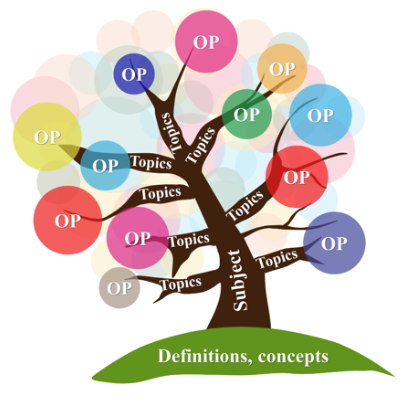
Source: Author's own elaboration
Therefore, inexperienced researchers are confronted with the Herculean task of carrying out a bibliographical revision or a state-of-the-art (depending on their problem and scope) for their research project, within this broad universe of preexisting knowledge. Figure 2 includes some guiding questions to help researchers establish topics, OPs, and define the scope of the results. Alongside methods, tools and research possibilities, these questions contribute to an informed state-of-the-art.
Figure 2
Questions that help to limit the state-of-the-art

Source: Adapted from (Londoño Palacio, Maldonado
Granados, & Calderón Villafáñez, 2014)
Three hypothetical cases are presented. The first, (arguably the most straightforward for the beginner researcher), is when a research problem is already clearly defined (see OP23_n in Figure 3) and a bibliographic review may be sufficient to address the researcher’s needs. The second case, (see Topic1 in Figure 3), is when the topic is clearly defined but the research problem is not. In this case, the researcher in training must search for exhaustive information to find their OP(s) and define the one(s) they will seek to solve. The third case occurs when an investigator starts on the subject and has not yet clearly defined either the topic nor the problems to be solved.
For the last hypothetical case, it is advisable to first orient the bibliographic research with general research questions that help the researcher locate other individuals and research groups working on solutions around the subject, the publications where their results are typically reported, and the histogram of publications for their topic. These actions will help narrow the topic for investigation and identify potential OPs.
In order to establish open research problems, a subject is taken as a starting point. A subject contains potential topics of interest to the researcher while the topics contain several open problems, so that finally the researcher can embark on investigating the state-of-the-art for the problem selected. (See Figure 3)
Figure 3
Subject, topic, and open problems
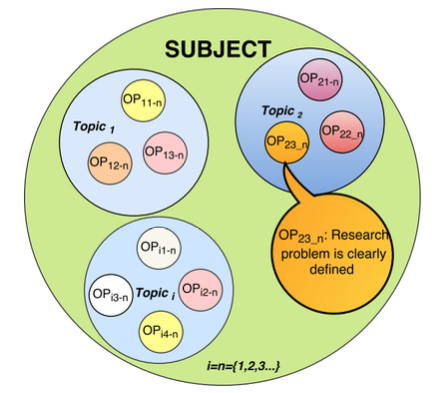
Source: Author's own elaboration.
The search for adequate or pertinent information requires a clearly defined goal or clarity about the results that are expected to be obtained, through a process of searching and selecting the material, and then through the analysis and evaluation of the data.
In the field of software engineering (computer science), we can find two methodologies to process and organize the information relative to the research: Systematic Literature Reviews and Mapping Studies (B. Kitchenham, Brereton, & Budgen, 2010; Sepulveda, Cravero, & Cares, 2017). A Systematic Literature Review (SLR) presents relevant information by comparing the procedures, technologies, and techniques of a specific topic. Mapping Studies (MS), through the classification and thematic analysis of the reviewed literature, offer information on a general topic (Marshall & Brereton, 2013).
In (B. A. Kitchenham, Budgen, & Pearl Brereton, 2011), MS is used on itself to investigate how mapping studies contribute to further research. One of the important differences in methodologies is that conventional SLRs attempt to group primary studies in terms of research results and investigates whether the research results are consistent or contradictory. By contrast, MS usually only aims to classify relevant literature and studies with respect to categories based on published information (i.e. journal, author, etc.) and/or research methods used.
In (Krull & Duart, 2017), the steps are set as follows: First, formulate the research problem, then search the literature and gather information from studies, evaluate the quality of those studies, and second, analyze and integrate the outcomes of research, interpreting the evidence before finally presenting the results for Research Trends in Mobile Learning in Higher Education.
Table 1. shown three examples, which indicate the steps suggested for the investigation. In (Petersen, Vakkalanka, & Kuzniarz, 2015), propose a methodology used in software engineering, in order to search for general characteristics of the topic. Initially, research questions raise, because, the topic is not clearly defined. After the selection of information quality, data of interest to analyze and classify the selected information raises. Finally, the results are evaluated, and validated.
Another methodology presented is from the field of electrical engineering by (Gómez-Luna, Navas, Aponte-Mayor, & Betancourt-Buitrago, 2014), which seeks to obtain a comprehensive state-of-the-art. With this methodology, the research question must already be defined. Initially, it consists of the search for information in books, journals, conference proceedings, technical reports, standards, theses and the Internet. The next step is to organize the information using spreadsheets or bibliographic managers, and finally, to perform an analysis of the information collated.
In the field of medicine, (Vilanova, 2012) proposes a methodology that aims to establish the main sources of information, such as: textbooks, biomedical journals, bibliographic databases and secondary Clinical Practice Guidelines, Health Technology Assessment Agency Reports, Review Files, Structured Summaries Journals Systematic reviews and/or meta-analyses. Search planning consists of establishing keywords and using logical operators. The third is the critical evaluation of the information through the reading of summaries and conclusions, as well as assessing the materials used, their source, year of publication, and origin. Finally, a bibliography is generated with reference managers.
Table 1
Some methodologies for research in three different field of science.
(Petersen et al., 2015) |
(Gómez-Luna et al., 2014) |
(Vilanova, 2012) |
Research questions |
Definition of questions |
Establish sources of information |
Search |
Search of information |
Search planning |
Study selection and quality assessment |
Organization of information |
Critical evaluation of information |
Data extraction |
||
Analysis and classification |
Analysis of information |
Organization of the bibliography |
Validity evaluation |
Source: Author's own elaboration. (Gómez-Luna et al., 2014)
Table 1. establish the different steps, scope, and methods used in different fields of knowledge. For Peterson et al., the search spectrum is very broad, as it collects information from databases and all kinds of material available on the web. Luna et al. establish a revision of the state-of-the-art around the research question, initiating the search from databases. Vilanova initially establishes databases as a first step, next, defines the research to be carried out.
From the approach of the Scientific Method, this research is carried out using observation, analysis and deduction. Into four fundamental parts is divided proposed methodology: definition of the open research problems, then establish databases, later validate the information, and generate some research problems. (See Figure 4).
Figure 4
Flowchart of the methodology developed
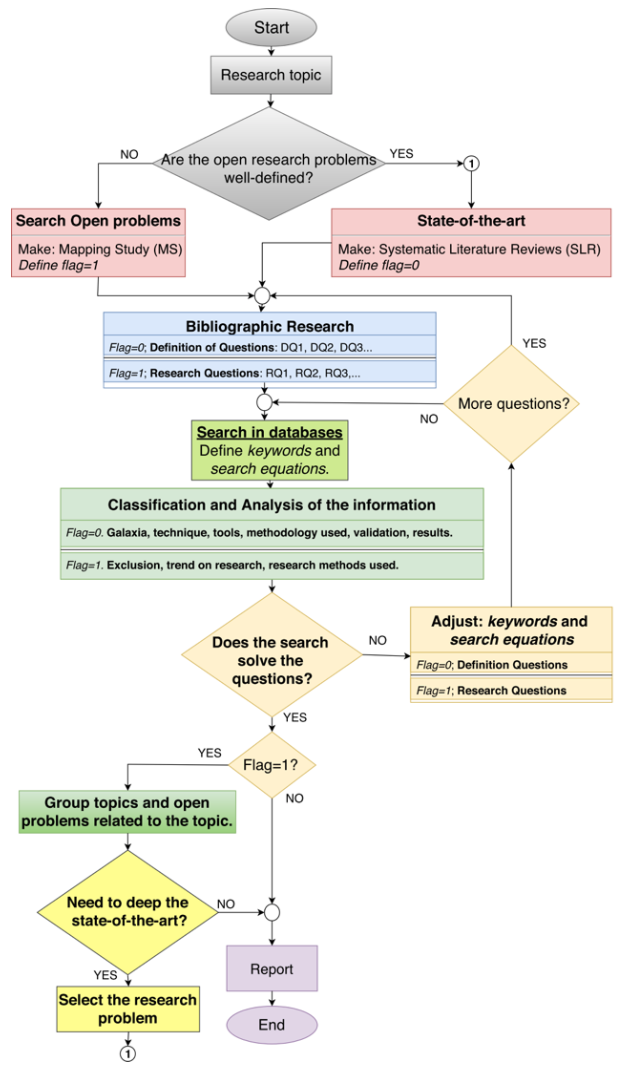
Source: Author's own elaboration
Additionally, some important free tools include bibliographic managers such as Jabref (Alves & Batada, 2018), and Mendeley (Mendeley Ltd., 2017), that enable the rapid classification and/or merging of information, as well as the creation of categories and storage of the required information. There are also programs such as Docear (Beel, Gipp, Langer, & Genzmehr, 2011), which allow you to use various tools such as managers and mental maps with a single application, facilitating the synthesis and preparation of a report.
•DQ1. What are the challenges of teaching control?
•DQ2. What are the developments in low-cost platforms for teaching control?
Search in databases of scientific publications.
The words of interest to develop the proposed methodology are control, low-cost, experiment, home-plant. The search equations were defined using logical operators and the characteristics of the advanced search of every database: In the Web of Science: T (control AND low-cost) where T is Title, where TAK=Title-Abstract-Keywords. In ScienceDirect, Title is selected and the search is ‘TITLE(control) and TITLE(home-plant)". In IEEE, Document Title is selected, as it is of interest in this document.
•TAK(control AND laboratory) and TAK(control AND home-plant)
•TITLE(control AND laboratory) and TITLE(control AND laboratory AND low-cost)
DQ1: Several authors such as (Astrom, 1991); (Grimaldi & Rapuano, 2009); (Pastor, Hernández, Ros, & Castro, 2006) agree that there must be a balance between theory and practice. Laboratories should include all possible factors that influence a real process (i.e. dead time, saturation, etc.) but the use of these types of tools should be gradual, starting with a low level and increasing the difficulty levels of the subjects processed.
DQ2: Table 2 shows some developments made by educational institutions towards automatic control learning. The master's work developed by (Plazas-Rosas, 2014) more extensive information about systems of experimentation of low-cost.
Table 2
Prototypes for learning in automatic control.
Systems (Variable) |
Software |
|
Licensed Program |
Open Source Program |
|
Servomechanism |
4 |
5 |
Temperature |
4 |
2 |
Pendulum |
3 |
4 |
Pneumatic |
2 |
3 |
Level |
1 |
1 |
Source: Author's own elaboration.
Report: The report is presented at a congress (Plazas-Rosas & Ramirez Scarpetta, 2012), highlighting the local low-cost experimentation teams developed by various universities, with the aim that the systems can be built and operated by students for enhancing the theoretical concepts seen in class.
Research questions are established because the research problem is not clearly defined.
Definition of research question
•RQ1. Which journals and events publish articles on invasive methods of blood pressure measurement?
•RQ2. Which R&D groups currently work on non-invasive blood pressure measurement?
•RQ3. Which topics are covered in non-invasive blood pressure measurement?
•RQ4. What are the most researched topics?
Search in databases of scientific publications. In the ScienceDirect and IEEE databases, search equations are set in both Expert and Advanced Mode according to the database. Include only the articles in whose TITLE and TAK the keywords appear simultaneously, where TAK=Title-Abstract-Keywords.
•TAK(arterial AND pressure AND measure AND noninvasive).
•TITLE(arterial AND pressure AND measure AND noninvasive)
•‘Document Title’:arterial AND ‘Document Title’:pressure AND ‘Document Title’:measure
Selection of articles: Documents not disseminated through the conventional channels of scientific publication (doctoral thesis, technical reports) may be excluded, as well as those considered to offer little significant contribution to the understanding of the topic. Others documents may be excluded, such as articles that are not classified as central texts on the subject or those with a publication date older than five years, (see Figure 5).
Figure 5
Examples of exclusion criteria
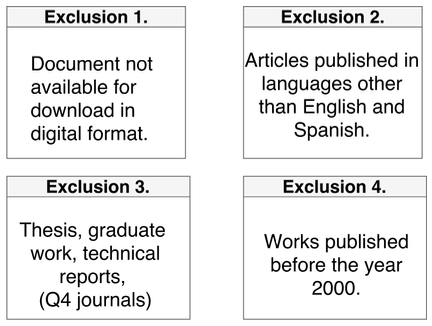
Source: Author's own elaboration.
Table 3 shows the results obtained from the databases using search equations with the keywords. - The search in the Title and in TAK is emphasized.
(See Figure 6 and Figure 7)
Figure 6
RQ1: Journals

Source: Author's own elaboration.
-----
Figure 7
RQ1: Conferences

Source: author's own elaboration
(see Table 4).
Table 4
R&D Group
R&D Group |
Place |
CSEM - Centre Suisse d'Electronique et de Microtechnique |
Neuchatel, Switzerland |
Department of Systems and Computer Engineering |
Ottawa, Canada |
Signal Processing Laboratory (LTS5), Ecole Polytechnique Fédérale de Lausanne |
Lausanne, Switzerland |
Source: Author's own elaboration
Topic trend. If there is uncertainty about a topic before starting the research, it is worth establishing whether the topic is in decline or it is rising and considered a growth area for research by the scientific community. The proposed procedure is performed using the algorithm shown in Figure 7. This algorithm is based on Figure 4, and two examples are presented: a rising topic - Functional Electrical Stimulation (FES) - and topic in decline – the Digital Versatile Disc (DVD).
Figure 8
Flowchart proposed for topic trends.
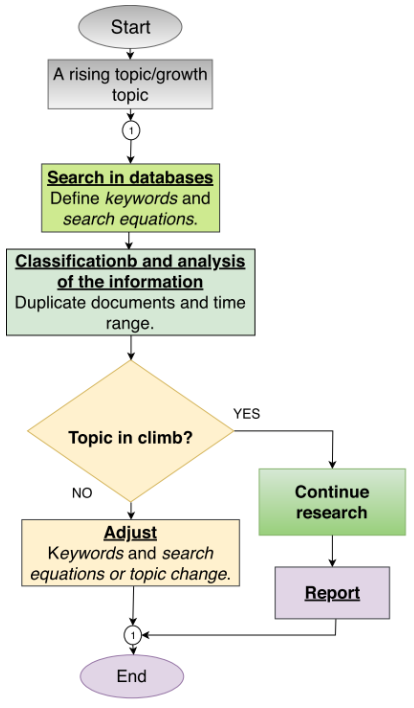
Source: Author's own elaboration
For FES:
•IEEE: ("Document Title": functional) AND "Document Title": electrical) AND "Document Title": stimulation)
•Science Direct: TITLE-ABSTR-KEY (functional AND electrical AND stimulation)
•Scopus: TITLE-ABS-KEY (“functional electrical stimulation”)
For DVD:
IEEE: "Document Title":"digital versatile disc" OR "Abstract":"digital versatile disc")
ScienceDirect:TITLE-ABSTR-KEY("digital versatile disc").
Scopus: TITLE-ABS-KEY (digital AND versatile AND disc)
Selection of articles: For the topic FES, articles were selected from the year 2008 onwards and for the topic DVD, from the year 1994 onwards. This time range corresponds to the possible trend that a topic can show. If there is any doubt about the trending of a topic, the selection time range can be lengthened. Bibliographic managers are used to avoid duplicate documents.
The results obtained from the databases and search equations show that the topic FES is of interest to the scientific community due to the increase in publications in recent years (see Figure 9 and Figure 10). On the other hand, the DVD is a topic that has fallen off in recent years, rendered virtually obsolete due to various technological advances such as connection to cloud storage. (See Figure 11)
Figure 9
Document by year for the topic FES

Source: Author's own elaboration
-----
Figure 10
Document by type for the topic FES

Source: Author's own elaboration.
-----
Figure 11
Document by year for the topic DVD

Source: Author's own elaboration
There is a wide variety of strategies to aid information searches when an investigation project is in its initial stages of formulation. For that reason, we aimed to present a clear, systematic methodology to assist the more inexperienced researcher to find information and establish their investigation problem(s), the scope, and objectives. Moreover, we presented three cases of application that describe how the methodology performs in real scenarios. Finally, we conclude that the questions that emerge in a project’s formulation stages, to undergraduate and graduate students, especially to doctoral students, in any field of knowledge and in different scenarios, it can be solved by using the proposed methodology. Offering a strong starting point for the investigation, preventing groups or research centers from starting the investigation from scratch, and unveiling the spectrum of existing or potential projects that exist in a specific field.
This work has been financed by a Doctoral Scholarship: “Formación del capital humano de alto nivel para el Departamento de Boyacá-Colciencias 733-2015”. In addition, the research Project “Formación de competencias en diagnóstico de fallas para tecnólogos e ingenieros eléctricos y electrónicos –Aplicación a diagnóstico de sistemas de control”. Aug-2015 to Feb 2018. CI-2860 Universidad del Valle
Alves, M. O., & Batada, N. (2018). Jabref.
Aminifar, F., Meliopoulos, S., Baran, M., Romero-Aguero, J., Pahwa, A., Grijalva, S., … Giri, J. (2015). Guest Editorial Special Section on Monitoring, Visualization, and State Estimation for Distribution Systems. IEEE Transactions on Smart Grid, 6(4), 1999–2001. https://doi.org/10.1109/TSG.2015.2436011
Astrom, K. J. (1991). Education in Automatic Control at Lund Institute of Technology. In 1991 American Control Conference (pp. 306–311). IEEE. https://doi.org/10.23919/ACC.1991.4791376
Avella-Rodríguez, E. J. (2015). Diseño e implementación de una estrategia de control para la marcha asistida con el exoesqueleto de miembros inferiores de la Universidad del Valle. Master’s Thesis. Cali.
Baker, J. R., Brizee, A., & Velázquez, A. (2013). Choosing a Topic. Retrieved August 15, 2018, from https://owl.english.purdue.edu/owl/resource/658/03/
Bastidas-Rodriguez, J. D., Franco-Mejia, E., Petrone, G., Ramos-Paja, C. A., & Spagnuolo, G. (2014). Maximum power point tracking architectures for photovoltaic systems in mismatching conditions: a review. IET Power Electronics, 7(6), 1396–1413. https://doi.org/10.1049/iet-pel.2013.0406
Beel, J., Gipp, B., Langer, S., & Genzmehr, M. (2011). Docear. In Proceeding of the 11th annual international ACM/IEEE joint conference on Digital libraries - JCDL ’11 (p. 465). New York, New York, USA: ACM Press. https://doi.org/10.1145/1998076.1998188
Gómez-Luna, E., Aponte Mayor, G., Gonzalez-Garcia, C., & Pleite Guerra, J. (2013). Current Status and Future Trends in Frequency-Response Analysis With a Transformer in Service. IEEE Transactions on Power Delivery, 28(2), 1024–1031. https://doi.org/10.1109/TPWRD.2012.2234141
Gómez-Luna, E., Navas, D. F., Aponte-Mayor, G., & Betancourt-Buitrago, L. A. (2014). Literature review methodology for scientific and information management, through its structuring and systematization. DYNA, 81(184), 158. https://doi.org/10.15446/dyna.v81n184.37066
Grimaldi, D., & Rapuano, S. (2009). Hardware and software to design virtual laboratory for education in instrumentation and measurement. Measurement, 42(4), 485–493. https://doi.org/10.1016/j.measurement.2008.09.003
Institute for Writing Rhetoric. Dartmouth College. (2016). Coming up with your topic. Retrieved August 15, 2017, from http://writing-speech.dartmouth.edu/learning/materials/materials-first-year-writers/what-academic-paper#topic
Jaramillo, H. (2009). La formación de posgrado en Colombia: maestrías y doctorados. Revista Iberoamericana de Ciencia, Tecnología y Sociedad - CTS, 5(13), 1–26.
Jiang, T., & Zheng, X. (2016). A Survey for Information Technology Based Roll Call Methods in University Education. In 2016 8th International Conference on Information Technology in Medicine and Education (ITME) (pp. 410–413). IEEE. https://doi.org/10.1109/ITME.2016.0098
Kitchenham, B., Brereton, P., & Budgen, D. (2010). The educational value of mapping studies of software engineering literature. In Proceedings of the 32nd ACM/IEEE International Conference on Software Engineering - ICSE ’10 (Vol. 1, p. 589). New York, New York, USA: ACM Press. https://doi.org/10.1145/1806799.1806887
Kitchenham, B. A., Budgen, D., & Pearl Brereton, O. (2011). Using mapping studies as the basis for further research – A participant-observer case study. Information and Software Technology, 53(6), 638–651. https://doi.org/10.1016/j.infsof.2010.12.011
Krull, G., & Duart, J. M. (2017). Research Trends in Mobile Learning in Higher Education: A Systematic Review of Articles (2011 – 2015). The International Review of Research in Open and Distributed Learning, 18(7). https://doi.org/10.19173/irrodl.v18i7.2893
Labaree, R. V. (2017). Research Guides: Organizing Your Social Sciences Research Paper: The Research Problem/Question. Retrieved August 15, 2017, from http://libguides.usc.edu/writingguide/researchproblem
Londoño Palacio, O. L., Maldonado Granados, L. F., & Calderón Villafáñez, L. C. (2014). Guía para construir estados del arte. Retrieved August 5, 2018, from http://www.colombiaaprende.edu.co/html/investigadores/1609/articles-322806_recurso_1.pdf
Marshall, C., & Brereton, P. (2013). Tools to Support Systematic Literature Reviews in Software Engineering: A Mapping Study. In 2013 ACM / IEEE International Symposium on Empirical Software Engineering and Measurement (pp. 296–299). IEEE. https://doi.org/10.1109/ESEM.2013.32
Mendeley Ltd. (2017). Mendeley. Retrieved January 1, 2018, from https://www.mendeley.com
Ministerio de Educación Nacional de Colombia. (2018). Sistema de Información del Observatorio Laboral. Retrieved August 15, 2018, from http://www.graduadoscolombia.edu.co/html/1732/w3-channel.html
Núñez S., J., Lascano F., S., & Esparragoza, I. E. (2013). A project-based learning approach for a first-year engineering course. In Eleventh LACCEI Latin American and Caribbean Conference for Engineering and Technology (LACCEI’2013) (pp. 1–10). Cancun, Mexico.
Pastor, R., Hernández, R., Ros, S., & Castro, M. (2006). Especificación Metodológica de la Implementación y Desarrollo de Entornos de Experimentación. IEEE-RITA, 1(1), 27–35.
Petersen, K., Vakkalanka, S., & Kuzniarz, L. (2015). Guidelines for conducting systematic mapping studies in software engineering: An update. Information and Software Technology, 64(8), 1–18. https://doi.org/10.1016/j.infsof.2015.03.007
Plazas-Rosas, R. A. (2014). Recursos de experimentación locales y portables para el aprendizaje basado en proyectos de sistemas de control. Master’s Thesis. Cali: Universidad del Valle. Grupo de Investigación en Control Industrial.
Plazas-Rosas, R. A., & Ramirez Scarpetta, J. M. (2012). Herramientas de experimentación local en los Sistemas de Control: Una Revisión. In IX Congreso Internacional Electrónica y Tecnologías de Avanzada. Pamplona, CO.
Rengifo, C. F. (2015). Directrices para la realización de clasificaciones sistemáticas de publicaciones científicas. Class Notes. Popayan.
Sepulveda, C., Cravero, A., & Cares, C. (2017). From Business Process to Data Model: A Systematic Mapping Study. IEEE Latin America Transactions, 15(4), 729–736. https://doi.org/10.1109/TLA.2017.7896401
Sugiyama, K., & Meyer, B. (2008). Knowledge process analysis: Framework and experience. Journal of Systems Science and Systems Engineering, 17(1), 86–108. https://doi.org/10.1007/s11518-008-5069-7
University of California Santa Cruz. (2018). Choose a topic. Retrieved August 15, 2018, from http://library.ucsc.edu/help/research/choose-a-topic
Vilanova, J. C. (2012). Revisión bibliográfica del tema de estudio de un proyecto de investigación. Radiología, 54(2), 108–114. https://doi.org/10.1016/j.rx.2011.05.015
1. Electronic Engineer, MSc in Automation, currently working toward the Ph.D. Degree in Universidad del Valle. Contact ramiro.plazas@correounivalle.edu.co
2. Electrical Engineer, Master’s Degree in Automation, and the Engineering Doctor Degree from the Universidad del Valle, Cali, Colombia. Full-Time Professor with the Universidad del Valle. Contact edinson.franco@correounivalle.edu.co